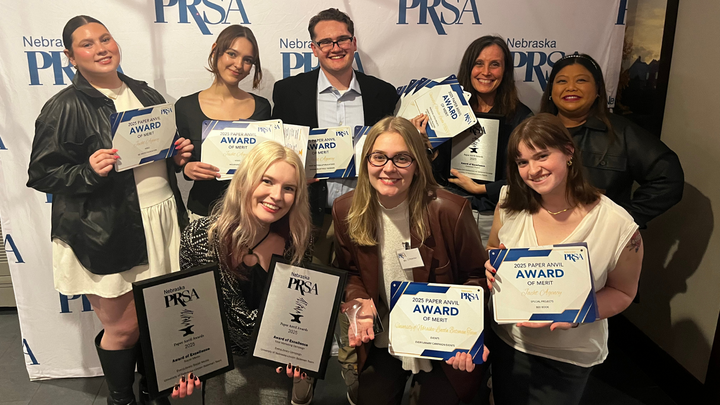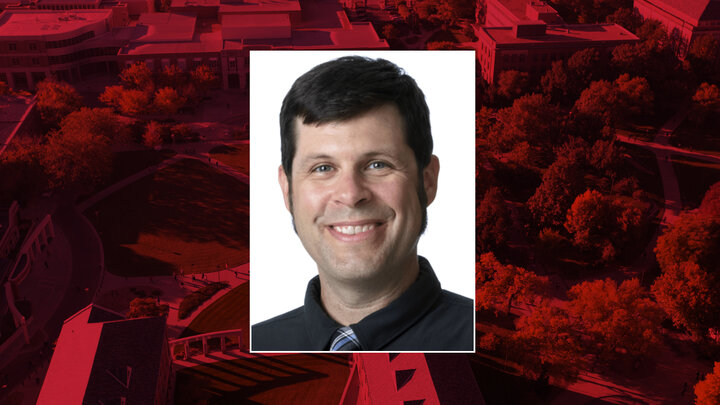Our transformation
Scholarly productivity in CoJMC has evolved over the last decade. Traditionally, our faculty was comprised of former media professionals serving as faculty and administrators; thus, much of the scholarship and creative activity was industry-focused, while little focus was placed on traditional academic research.
In their 2010 site team report, the college’s accrediting body, the Accrediting Council on Education in Journalism and Mass Communications, cited Nebraska as having “a record of scholarly and creative activity that is below most programs housed in Research I and AAU institutions and lack of hires with terminal degrees who could boost scholarly productivity.”
Two years after this report, the University of Nebraska-Lincoln joined the Big Ten Academic Alliance, and the colleges began an evolution toward national recognition in research and creative activity.
Over the past 10 years, the college has transformed its faculty from industry-centered professionals to a balance of research-active and professionally oriented faculty; established clear expectations and policies for faculty advancements; made investments into research and creative activity; and developed mechanisms to recognize and reward achievements in research and creative activity.
These activities have led to a dramatic increase in the depth, breadth and scope of research undertaken by the college. The 2023 ACEJM site team report noted that “the college requires, supports and rewards scholarly and creative activity. Faculty members attend major conferences; they share their research through venues such as panels, public forums and events. In recent years, they have also expanded their profile beyond the university.”
We are now on the precipice of significant research output and national recognition. Additional investment in the College of Journalism and Mass Communications provides an opportunity to propel scholarship and establish a national reputation as a leader in journalism and mass communication research.
Our faculty
As noted in the 2010 ACEJMC site team report, the college traditionally hired former media professionals lacking terminal degrees. Additionally, the standard faculty apportionment was 70% teaching, 15% research and 15% service, with tenure-track faculty members teaching six courses per year.
To begin to create space for research and creative activity, the College adopted new standard apportionment guidelines in 2012. Pre-tenure faculty members now have an apportionment of 50% teaching (2-2), 40% research and 10% service, while tenured faculty have an apportionment of 60% teaching (2-3), 30% research and 10% service.
While our teaching apportionment remains higher than that of our peer institutions, these guidelines have enabled our faculty to more meaningfully engage in research and creative activity.
Additionally, through strategic hiring, the college has successfully altered the profile of its faculty from industry-centered to a balance of research-active and professionally oriented faculty. In 2010, the ACEJMC site team noted that the college had 32 full-time faculty, nine of whom had Ph.D. or 28% of the faculty. In 2023, the college had 33 full-time faculty, 16 with a Ph.D. or 51%.
Our policies and procedures
In addition to adjusting the profile of our faculty, the college has twice updated its promotion and tenure guidelines in the past 10 years. Each adjustment elevated the expectations of research and creative activity needed to attain tenure and communicated the value the college places on scholarship.
In 2022, the college also introduced a faculty development leave policy. While the university has maintained a policy for many years, the availability of faculty development leave was not well known or well utilized within the college. The new policy communicated to faculty not only the opportunity but also the value of pursuing faculty development leave. The clear process for considering leave requests also reduced uncertainty surrounding faculty leaves.
The adoption had a swift and immediate impact. The number of leave requests dramatically increased as faculty took advantage of this opportunity to advance their scholarship.
- Upcoming Spring 2025: John Shrader will conduct interviews and develop a podcast series leading to a book that examines the current state of sports journalism.
- Upcoming Spring 2025: Dane Kiambi will conduct in-depth interviews and prepare two manuscripts focused on public relations practices, challenges and opportunities for Kenyan county governments.
- Upcoming Fall 2024: Matt Waite will develop open-source interactive data journalism tutorials in R.
- Upcoming Fall 2024: Valerie Jones will develop software for older adults to interact with voice assistants and pilot new measures of social connection not yet tested in the U.S.
- Fulbright Award Spring 2023--Valerie Jones. Jones received a Fulbright award to Australia. She worked with the Social Innovation Research Institute at Swinburne University of Technology, exploring how emergent technologies, specifically voice assistants, activate social connection and influence loneliness among aging adults.
- Fall 2023--Barney McCoy: McCoy produced “Running Toward The Fire: A War Correspondent’s Story,” about a Nebraska native who developed journalistic content during World War II. It will premier on May 1, 2024.
- Fall 2022: Frauke Hachtmann: Hachtmann wrote a book “Crisis Response Advertising: Insights and Implications from COVID-19 (Routledge).” Copyright 2024.
- Spring 2022: Changmin Yan: Yan collected data on a D&I training program and presented the research in Fall 2022 at a regional conference. He is preparing a manuscript based on the study.
- Spring 2021 (postponed from Fall 2020 due to COVID-19 restrictions): Ming (Bryan) Wang: Wang conducted in-depth interviews with oncologists and cancer patients to probe their information-seeking behavior on social media and their attitudes toward adopting AI-driven communication technologies in cancer communication. He has one manuscript under review and one publication from that project.
Investment in resources
Over the past 10 years, the college has invested resources and created programs to support faculty research and creative activity.
In 2014, under the leadership of Interim Dean James O’Hanlon, the college began providing start-up packages to new faculty to catalyze their research activities. In 2015, under the leadership of Dean Maria Marron, the college standardized faculty start-up packages at $15,000 for all tenure-line faculty hires, to be used within five years of hire. Dean Shari Veil has maintained the standard $15,000 start-up package but has reduced the timeline for utilization from five years to three years to encourage faculty to jump-start their research agenda.
The college has also established a seed grant program to support the initiation of a faculty project that will lead to publication, national recognition or additional funding for the college. While the program was established in 2015, it was underutilized and averaged about one $2,000 seed grant per year.
In 2022, the college hired an associate dean for research and faculty affairs, Cory Armstrong, to focus on advancing faculty scholarship. Armstrong initiated a series of individual meetings with faculty to learn about their research and creative activity and connect them to resources, including the college’s seed grant program. The result of this initiative has been a dramatic increase in the seed grant requests and awards for college faculty.
The program is available to all full-time faculty in the college and provides grants of up to $5,000. Applications are taken on a rolling basis, and the college’s executive committee determines awards—the goal is to provide some beginning funds for projects that then can lead to external funding or larger collaborations. Some faculty have joined together for projects, including the purchase of Sprinklr social media software licenses, which are used by several members of the faculty and students for classes and research projects. Total allocations for seed grants from 2016 to 2024 total $59,091. The list below demonstrates the breadth of research projects faculty have launched with seed grant funds.
| First Name | Last Name | Project | Amount |
| Cory | Armstrong | 2023-24 Academic year Sprinklr use funds | $ 5,000 |
| Kelli | Boling | Journalists, Roe, and Twitter: Two studies to better understand how journalists tweeted about the Roe v Wade leak and decision | $ 5,000 |
| Michelle | Hassler | Using participatory mobile tools to engage low-income communities and co-produce news | $ 5,000 |
| Shoun | Hill | A portrait study of those from the African Diaspora working, studying at predominantly white institutions | $ 2,260 |
| Valerie | Jones | 2022-23 Academic year Sprinklr Use Funds | $ 5,000 |
| Valerie | Jones | Reducing loneliness among aging adults: The roles of personal voice assistants and anthropomorphic interactions | $ 1,850 |
| Barney | McCoy | Beverly Keever "Nebraska Stories" for Nebraska Public Media | $ 2,000 |
| Barney | McCoy | "Running Towards the Fire” documentary | $ 5,000 |
| Barney | McCoy | Black Jack Pershing: Love and War documentary | $ 1,281 |
| Luis | Peon-Casanova | Emerging technology in videography | $ 4,200 |
| Jason | Stamm | COVID, NIL and mental health: How collegiate student athletes juggle increased pressures and stressors | $ 2,000 |
| Matt | Waite | Open AI Premium account | $500 |
| Jessica | Walsh | Thematic analysis of local news coverage of water issues in Nebraska | $ 5,000 |
| Jessica | Walsh | A study of retention and recruitment at weekly newspapers in states with news deserts | $ 5,000 |
| Jessica | Walsh | Transformational leadership in a small, rural-serving U.S. newsroom | $ 5,000 |
| Bryan | Wang | Using algorithmic media literacy to build public resilience to online misinformation | $ 5,000 |
The college has also established and grown a faculty travel grant program. The 2010 ACEJMC site team report noted that at the time, faculty were only provided with $135 per year to support travel. In 2015, the college pursued an amendment to an existing foundation fund to establish the Seacrest Travel Grant Fund specifically to support faculty travel.
In the initial iteration of the program, faculty were limited to two funded trips per year. The program was successful, and faculty began to travel more frequently to participate in conferences. However, the college noticed that productive faculty were limited in their ability to report the results of their research, while program funding remained reserved for faculty who chose not to engage in travel.
The program was amended in 2017 to eliminate the restriction on trips but institute funding levels for different types of travel activities. The college prioritized the presentation of research and creative activity by providing a higher level of funding for travel for this purpose.
As faculty have engaged in more research in the college, the utilization of this program has grown, and expenditures from the travel grant program have increased.
Fiscal year 2024 expenditures are to April 15, 2024. Additional expenses in 2024 are expected.
Recognition and Promotion
The college has increased its recognition and promotion of research and creative activity. In 2020, Dean Shari Veil instituted a competitive process for the awarding of college professorships, which recognizes achievement in research and provides additional resources to engaged faculty.
In 2020, the college awarded three professorships through this new process. Professor Frauke Hachtmann was awarded the Kearns Chair in Journalism, and Associate Professors Dane Kiambi and Valerie Jones were awarded the Seaton Professorship. Jones' appointment was renewed in 2023, again through a competitive process recognizing her research achievement.
The college also established a section on its website to recognize and promote research and creative activity. The section contains our faculty expertise, which was again updated in 2024, recent research news and a link to the Public Insight Lab, a center to conduct social media research using cutting-edge software.
In addition to prominent placement on the college’s website, the college has increased other forms of recognition, including recognizing publications and presentations in our weekly faculty and staff newsletter, including stories and listing of research and creative activity in our annual reports and increasing stories about research achievements.
Our growth
The transformation of our college from an industry-centric program to a unit befitting a Research 1 institution has resulted in a dramatic increase in our research and creative output.
The gold standard for research and creative activity is the production of peer-reviewed journal articles. The college has been trending upward over the past 10 years, with a significant increase beginning in 2020.
Digging into publications, we see that our junior faculty and recent hires have produced publications in top mass communication journals since 2021, including Health Communication, Social Media + Society, Communication and Sport, Journalism & Mass Communications Quarterly, and Mass Communication & Society. Pursuing and publishing in top-tier publications provides additional visibility for our faculty and university.
A majority of our journal articles have been produced by junior faculty. Between 2020 and 2023, the college published 59 journal articles; 35, or 59%, were published by assistant professors.
Our faculty have also increased grant activity.
In the last three years, we have seen a dramatic increase in grants, particularly internal grants. Some notable highlights include our successes in UNL’s Grand Challenges. Faculty are PIs or Co-PIs on two catalyst grants and four planning grants. Four faculty have received innovation grants from the UNMC’s College of Public Health. Jessica Fargen-Walsh became a faculty fellow for the Daugherty Water Institute.
Our junior faculty have started to expand their grant activity to external funding sources. For example, Ciera Kirkpatrick received a $3,500 AEJMC Emerging Scholars Grant for her work.
While many of these are small grants, the networking and production outcomes from that funding generally lead to additional funding and outputs. With our increased research output and jump in internal grant applications, our faculty is poised to pursue external funding to support their research and creative activity.
In addition to articles and grants, there are other indicators that we can expect increased research and creative activity from the college. Conference presentations have grown from 52 in 2014 to 82 in 2023, an increase of 57%. Additionally, participation in professional development activities has grown from 52 in 2015 to 165 in 2023.
Poised for the future
The College of Journalism and Mass Communications is poised for an explosion of research and creative activity that will propel us toward the nation’s leading institutions. To maintain our momentum and take the next step toward the level of productivity expected of an R1 institution, the college needs to continue to invest in our faculty and research support programs.
Faculty hiring needs must be balanced between the need to further enhance our expertise and research capacity and meet the needs of students through course offerings. The college must reduce the teaching load of our tenured faculty from 3-2 to 2-2 to align with our peers. This reduction requires additional teaching capacity.
Faculty hiring needs include tenure-line faculty with Ph.D.s and demonstrated research productivity who can contribute to the college's burgeoning and strategically important areas of expertise, including risk and crisis communication, health and science communication, environmental communication, emerging technology and national security.
Faculty Investment
The college plans to propose cluster hires to further our research mission. The college is evaluating the cost of investing in more senior faculty or building teams of junior faculty with significant potential. The estimated salary costs are included below.
Area | Senior Faculty | Junior Faculty |
Risk/Health Campaigns | $226,883 (2 faculty) | $254,848 (3 faculty) |
Science/Environmental Communication | $301,852 (2 faculty) | $260,605 (3 faculty) |
Misinformation/AI/Data Science |
| $506,498 (6 faculty) |
Program Investment
The college’s resources to support seed grants and travel grants are limited. Cash reserves built up over past years have supported recent increases in the utilization of these programs. However, these reserves have dwindled, and new resources are needed to support faculty travel and grants at their current levels.
Seed Grant Program
The college has $10,000 in annual funding to support seed grant proposals. The last two year’s activity indicates that the college needs to increase this $15,000 annually to support seed grant proposals at the current level. The expansion of our faculty would dictate the further expansion of this program.
Travel Grants
The college spent $53,344 on travel grants in fiscal year 2023 and is on track to spend a similar amount in 2024. The travel grant program is supported by $31,648 in recurrent funding. To continue supporting faculty at the current level, the college needs to identify an additional $25,000 in travel support funding annually.




